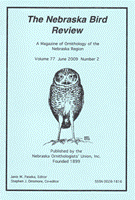Nebraska Ornithologists' Union

Nebraska Bird Review
Date of this Version
6-2008
Document Type
Article
Citation
“Endangered Species Responses to Natural Habitat Declines: Nebraska’s Interior Least Terns (Sternula antillarum athalassos) and Piping Plovers (Charadrius melodus) Nesting in a Human-Created Habitat” from Nebraska Bird Review (June 2008) 76(2).
Abstract
Formerly, state and federally endangered Interior Least Terns (Sternula antillarum athalassos) and state and federally threatened Piping Plovers (Charadrius melodus) nested on sandbars in rivers as well as on other sandy beach habitat (Hardy 1957; Haig 1992; Kirsch 1992; Ziewitz et al. 1992; Thompson et al. 1997). In Nebraska, the birds primarily used sandbars in the Platte, Loup, Elkhorn, Niobrara, and Missouri rivers (Sharpe et al. 2001). These sandbars were created and maintained by river flow and regular flooding events. Despite the frequent scouring, reshaping, and relocation of the sandbars, nesting habitat was consistently available to the birds in these river systems. With recent human-caused modifications to annual river flow, river bed and bank structure, and emergent vegetation, the number of river sandbars that are suitable for nesting has been greatly reduced (Haig 1992; Ziewitz et al. 1992; Wilson et al. 1993; Thompson et al. 1997; NRC 2005).
In recent decades, Least Terns and Piping Plovers have used human-created habitats for nesting, although they still use river sandbars when they are available (Haig 1992; Thompson et al. 1997). During the last several decades, the birds have nested on human-created sites such as sand spill piles at sand and gravel mines, fly-ash piles at electrical power-generating plants, gravel and tar rooftops, and lakeshore-sandy beach housing developments (Ducey 1982; Haig 1992; Kirsch 1992; Ziewitz et al. 1992; Wilson et al.1993; Thompson et al. 1997; Forys and Borboen-Abrams 2006). In eastern Nebraska, economic growth near human population centers has increased the attractiveness of lakeshore housing developments to investors. In the past, retired sand and gravel mines were converted into lakeshore housing developments. Recently, however, developers have bypassed the mine stage and are excavating the lakes directly for housing developments.
As terns and plovers use human-created and human-dominated habitats with increasing frequency, the importance of these areas to conservation and management becomes more critical. Threats to nests, chicks, and adults may be quite different at these sites than at river nesting sites or sand and gravel mines because of different human uses. Reliable nesting data are essential for the development of effective protocols to secure and recover the populations of these two protected species. Here we report the results of one nesting season at a human-created site along the lower Platte River.


Comments
Copyright 2008 Nebraska Ornithologists’ Union. Used by permission.